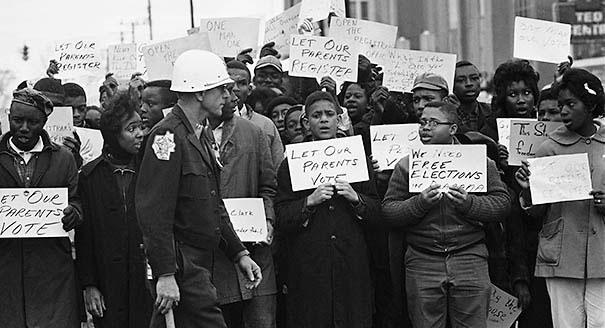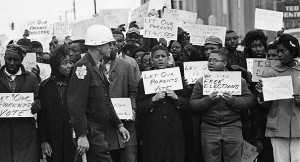
Dismantling Voting Rights Part I: Historical Background
January 4, 2014Student Blogs Article“Today the Supreme Court stuck a dagger into the heart of the Voting Rights Act of 1965, one of the most effective pieces of legislation Congress has passed in the last 50 years.
“These men never stood in unmovable lines. They were never denied the right to participate in the democratic process. They were never beaten, jailed, run off their farms or fired from their jobs. No one they knew died simply trying to register to vote. They are not the victims of gerrymandering or contemporary unjust schemes to maneuver them out of their constitutional rights.” — Congressman John Lewis
On June 25, 2013, the Supreme Court of the United States handed down its decision in Shelby County v. Holder. Effectively gutting the Voting Rights Act of 1965 (VRA), the 5-4 majority held Section 4(b) of this landmark civil rights legislation unconstitutional. The Court upheld Section 5, which imposes a requirement that jurisdictions with a history of voter disenfranchisement receive federal preclearance before making changes to voting laws. Without Section 4(b)’s coverage formula for determining which jurisdictions require preclearance, however, Section 5 becomes essentially unenforceable. Until Congress passes new parameters for designating what municipalities remain bound by Section 5, the VRA offers little protection against voter disenfranchisement.
Shelby County could have devastating effects on voting rights across America. Immediately following the Court’s decision, Texas Attorney General Greg Abbott announced plans to push forward a voter ID law that a federal court previously blocked under the VRA. Texas is one of thirty-four states with voter ID laws, which many argue disproportionately impact minority voters. The Brennan Center for Justice reports that 20% of minorities lack proper identification required by these new laws.
This is not the first time that states have used a rescission of federal intervention as an opportunity to implement voting barriers that target minority voters. Following the end of Reconstruction, southern states pounced upon their new-found freedom from Federal regulations, passing limitations on voting aimed at denying African-Americans their Fifteenth Amendment rights. Between 1877 and 1908, nearly every former Confederate states passed laws and rewrote their constitutions to include measures such as poll taxes, literacy tests, and grandfather clauses that severely restricted African-American voting. For example, the 1901 Alabama constitution – passed by an all-white caucus with the express purpose of “establish[ing] white supremacy” – included a literacy requirement and a poll tax. These disenfranchising provisions worked quickly. From 1900 to 1903, the number of registered black voters in Alabama decreased from 181,000 to less than 5,000.
The first half of the twentieth century saw myriad challenges at the Supreme Court to restrictive voting laws, with mixed results. In 1903, Jackson Giles, an African-American man from Alabama, went before the Supreme Court to contest the voting restrictions in Alabama’s new constitution. In his majority opinion, Oliver Wendell Holmes held that the Court was powerless to require Alabama to register black voters, and that “relief from a great political wrong” must come from Congress.
Disenfranchised black voters did, however, find some relief at the Supreme Court. In the 1915 landmark case Guinn v. United States, a unanimous Court held that Oklahoma’s grandfather clause was “repugnant to the prohibitions of the Fifteenth Amendment.” This decision marked an important victory for the fledgling National Association for the Advancement of Colored People (NAACP).
Despite successes at the Supreme Court, decisions in favor of voting rights had little actual impact. Even if the Court struck down disenfranchising statutes, states quickly responded with new laws that maintained systems of voter suppression. Following Guinn v. United States, the Oklahoma government passed a law with new voting restrictions. In three separate cases, the Supreme Court held all-white primaries in Texas unconstitutional. Each time the Court found a statute in violation of constitutional rights, the Texas legislature would slightly amend the law to maintain its discriminatory practices.
By the mid-1960s, owing largely to the efforts of the Civil Rights Movement, the American people and government had become increasingly aware of the systemic disenfranchisement of black voters. On March 7, 1965, peaceful demonstrators marched from Selma to Montgomery, Alabama, protesting the murder of voting rights activist Jimmie Lee Jackson. As the nearly 600 marchers left Selma, they met with approximately 150 Alabama state troopers, who proceeded to fire tear gas into the crowd and viciously beat the non-violent protesters. News media broadcast the images of “Bloody Sunday” across the nation and the world, prompting public outrage. One week later, on March 15, 1965, President Lyndon B. Johnson appeared before Congress and urged the legislature to pass the bill that became the Voting Rights Act.
You may also like
- April 2024
- March 2024
- February 2024
- November 2023
- October 2023
- April 2023
- March 2023
- February 2023
- January 2023
- December 2022
- November 2022
- October 2022
- May 2022
- April 2022
- March 2022
- February 2022
- January 2022
- December 2021
- November 2021
- October 2021
- May 2021
- April 2021
- March 2021
- February 2021
- January 2021
- November 2020
- October 2020
- September 2020
- August 2020
- July 2020
- June 2020
- May 2020
- April 2020
- March 2020
- February 2020
- January 2020
- November 2019
- October 2019
- September 2019
- April 2019
- February 2019
- December 2018
- November 2018
- October 2018
- September 2018
- March 2018
- February 2018
- January 2018
- December 2017
- November 2017
- October 2017
- September 2017
- May 2017
- April 2017
- March 2017
- February 2017
- December 2016
- November 2016
- October 2016
- April 2016
- March 2016
- February 2016
- January 2016
- December 2015
- November 2015
- October 2015
- June 2015
- May 2015
- April 2015
- March 2015
- February 2015
- January 2015
- December 2014
- November 2014
- October 2014
- August 2014
- March 2014
- February 2014
- January 2014
- December 2013
- November 2013
- October 2013
- September 2013
- May 2013
- April 2013
- March 2013
- February 2013
- January 2013
- December 2012
- November 2012
- October 2012
- September 2012
- June 2012
- April 2012
- March 2012
- February 2012
- January 2012
- December 2011
- November 2011
- October 2011
- September 2011
- August 2011
- April 2011
- March 2011
- November 2010
- October 2010
- September 2010

